About the Artifact

© Canadian Museum of Civilization, VI-I- 10, Photo Marie-Louise Deruaz, IMG2012-0171-0003-Dm
“The snowshoes of the Kutchin [Gwich’in] tribes are said to be all of identical type, with no more variations than those of individual craftsmen; they also are probably unsurpassed in fine workmanship by any in the world. There are two principal varieties, the hunting shoe and the trail shoe, the difference being merely a matter of size. The former variety are of a length more or less equal to the wearer’s height and serve to support the hunter while walking over fresh snow in search of game. The trail shoes are much smaller, being only large enough to support a person satisfactorily while walking over a trail already broken or packed down. Trail shoes become work shoes also when such labor is undertaken, which demands more facility in moving the feet than ability to get over the ground.
The same type of snowshoe satisfies both men and women, and children’s do not differ, except in size. The youngsters are adept at the age of six or seven and use them even earlier. When travelers are visiting in a village, they generally leave their snowshoes stuck in the snow at some distance outside. This is due simply to the fact that there is no need to carry them further and that they are safer from dogs, which eat the babiche lacings, and from being lost, if left outside along the trail.
The shoe frames, made by men, are preferably from birch wood. Spruce or willow supplants birch when the latter is not available. The form of the shoe, with its rounded front part, is so typical of the [Gwich’in] that they are frequently referred to in the literature of other tribes as the ‘Loucheux [Gwich’in] type’. Women generally do the netting of the shoes, but many men are likewise capable.”
— Cornelius Osgood, 1936